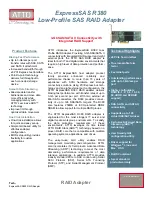
26
3-3 Glossary
1.
What is the IEEE 802.11ac standard?
2.4GHz Wireless 802.11b/g/n is the most commonly used wireless
standard. Because of this popularity, interference and lag are common in
the 2.4GHz network, especially in areas with a lot of wireless networks.
5GHz Wireless-AC was designed to get past this interference. Using a
different frequency allows 5GHz Wireless-AC to maintain high speeds
and throughput. The tradeoff of 5GHz Wireless-AC is the range is
reduced when compared to 2.4GHz wireless networks.
Wireless-AC is built on a Dual-Band standard. Dual-Band Technology
provides maximum flexibility allowing selection of the popular 2.4GHz
frequency for long range applications or or selection of the faster, less-
crowded 5GHz frequency for data intensive applications.
2.
What is the IEEE 802.11g standard?
802.11g is the new IEEE standard for high-speed wireless LAN
communications that provides for up to 54 Mbps data rate in the 2.4
GHz band. 802.11g is quickly becoming the next mainstream wireless
LAN technology for the home, office and public networks.
802.11g defines the use of the same OFDM modulation technique
specified in IEEE 802.11a for the 5 GHz frequency band and applies it
in the same 2.4 GHz frequency band as IEEE 802.11b. The 802.11g
standard requires backward compatibility with 802.11b.
The standard specifically calls for:
A.
A new physical layer for the 802.11 Medium Access Control (MAC)
in the 2.4 GHz frequency band, known as the extended rate PHY
(ERP). The ERP adds OFDM as a mandatory new coding scheme for
6, 12 and 24 Mbps (mandatory speeds), and 18, 36, 48 and 54 Mbps
(optional speeds). The ERP includes the modulation schemes found in
802.11b including CCK for 11 and 5.5 Mbps and Barker code
modulation for 2 and 1 Mbps.
B.
A protection mechanism called RTS/CTS that governs how 802.11g
devices and 802.11b devices interoperate.
3.
What is the IEEE 802.11b standard?
The IEEE 802.11b Wireless LAN standard subcommittee, which
formulates the standard for the industry. The objective is to enable
wireless LAN hardware from different manufactures to communicate.
Summary of Contents for HW17ACU
Page 6: ...V EU Countries Not intended for use None ...
Page 13: ...6 4 Click Next to continue ...
Page 15: ...8 ...
Page 16: ...9 7 A new icon will appear near the clock of system tray ...
Page 18: ...11 On Windows 8 and 10 it would appear like so With a list of networks above it ...
Page 22: ...15 5 Please click install ...
Page 23: ...16 6 Please type in your Mac User Account Password ...
Page 24: ...17 7 Click Continue Installation 8 The software should now install ...
Page 25: ...18 9 After the software completes the program will prompt you to restart Click Restart ...
Page 28: ...21 In a few seconds under Link Status you should see the HW17ACU connect to your network ...
Page 29: ...22 ...




































